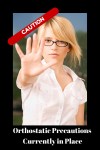“Just sit there on the side of your bed and get your head together first before we stand you up”
This or something very similar would have to be one of the most common words of advise nurses give to patients who complain of being a bit faint or dizzy on getting up. Is that it though? Is that the extent of our collective nursing wisdom that we have to offer? Are there other interventions that nurses can consider implementing.
Firstly nurses of all levels caring for patients need to have a good understanding of the mechanics of orthostatic hypotension (OH). OH is defined as:
A reduction of systolic blood pressure of at least 20mm Hg
or a reduction of diastolic blood pressure of at least 10mm Hg
within 3 minutes of standing
Nearly all instances of OH is detected within 1 minute and instances beyond 2 minutes provides information regards OH severity. OH is more likely to be detected by the measuring of lying and standing blood pressures in the early morning and also postprandially.
Prevalence of OH in the elderly in the community >70 years is estimated to be 30%. Complaints of symptomatic OH are more prevalent in elderly with Type 2 diabetes or cardiovascular diseases and in females. Symptoms include dizziness, faintness, light-headed and syncope. Not all cases of OH are symptomatic.
Managing OH is complex and difficult to treat. The aim of treatment is to increase blood volume, decrease venous pooling and increase vasoconstriction while minimising supine hypertension.
Informing medical staff of the presence of OH (symptomatic and asymptomatic) is the first nursing action. Part of the medical role is to identify the cause of OH, review current medication regime and determine if pharmacological intervention specifically to treat OH is required.
Once OH is identified and the cause proposed the role of the nurse is to provide patient education and in collaboration with the patient develop an individualised management plan. Patient education is vital. Information about OH, the symptoms and the strategies to reduce the effects of OH form the foundation of an effective patient education program.
Strategies worth considering by the nurse which have been shown to help patients in minimising OH symptoms fall into 3 categories as previously mentioned 1. increasing blood volume 2. decreasing venous pooling and 3. increasing vasoconstriction. Some of these strategies require very careful consideration of existing co-morbidities.
Increasing Blood Volume
- aim for 2-2.5 litres fluid a day
- head of bed raised 20-30 cm at night
- increase salt diet
- cold water bolus 500 mls
- high potassium diet (fruit and vegetables)
Decrease Venous Pooling
- calf pumps before standing
- maintain upright activity during the day
- prevent prolonged recumbency
- postural changes to be graduated
- mild physical exercise ideally in a seated position
- abdominal compression
- graduated compression stocking to the waist
Increase Vasoconstriction
- reduce or cease alcohol
- frequent small meals rather than large high carbohydrate dense meals
- minimise exposure to heat in the environment including showers and baths
Mild cases of OH may be adequately treated with patient education and non-pharmacological interventions. Moderate to severe cases of OH will additionally require prescribed drugs to assist in treating OH.
Its worthwhile asking the question what place does OH screening by nurses have in caring for older persons particularly in hospitals. What screening tools are available or is it as simple as measuring an early morning lying and standing blood pressure as soon as possible post admission.

